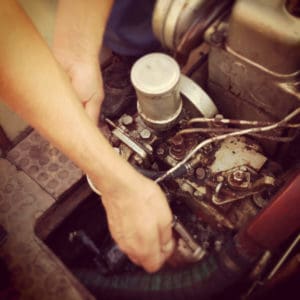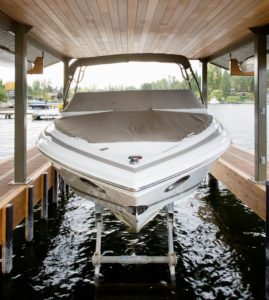Even the sturdiest boats are known to take some dings from poor landing, misplacing a drill hole, or dropping fishing equipment. On the bright side, these scratches and gaps in the gelcoat can be repaired with good technique and patience.
Today, we will take a look at the importance of a gelcoat for your vessel and explain the process of applying a DIY gelcoat.
What Is a Gelcoat?
Gelcoat is a special coating that is used to paint over the fibreglass on a boat’s hull. Gelcoat has polyester resin, epoxy, a catalyst, and other chemicals to make it protective against the elements. When combined with the fibreglass of the boat, it makes a smooth, durable surface that retards the hull from weakening in water and from ultraviolet light.
Typically, when the fibreglass mould is being made for the boat, the gel coat is applied—making it come out of the mould when it’s outside of the hull. Often, to give the boat a coloured and glossy finish, the pigments will blend with the gelcoat.
Different Types of Gelcoat
When it comes to gelcoats, there are two different types that you will want to research before deciding general-purpose gel coat and tooling gel coat.
- General Purpose Gelcoat. Typically, a general-purpose gelcoat is softer and more flexible. However, it is more prone to scratches than tooling gelcoat. The thickness of the general-purpose gelcoat is generally around .3-.7mm during the moulding process. It is also relatively flexible, so that it can adjust to the constant activity of the hull.
- Tooling Gelcoat. Generally, tooling gelcoat has an emphasis on properties like hardness. This focus is so that it can be polished to be of a higher lustre. Usually, tooling gelcoat is put on surfaces where movements are not desired.
How To Restore Gelcoat On A Boat
Many different techniques can be used for gelcoat repair, most depending on how severe the damage is.
Step #1. Figure Out The Boat Finish
It is important to note that gelcoat can not bond to painted surfaces, so make sure you know the type of finish on your boat. If your boat already has a polyester, fibreglass, or gelcoat resin on it, then there are no additional steps that need to be taken. A painted boat will need to have the paint removed before you can add any gelcoat.
Step #2. Prepare The Surface
When you reach the final layer of the gelcoat, there will be a waxy component to it. You will then have to remove the wax with a thinner of at least twice the diameter of the damaged area.
If there is a deeper repair, you may need to use a power drill to create a notch in the shape of a V to improve the bonding surface. Then, use sandpaper to remove any loose chips. After, clean the surface with acetone.
When preparing to gelcoat, you will want to put Painter’s Tape around the area you wish to coat. You’ll want to tape off any areas you don’t want to get the resin on and areas that could be damaged by gelcoat being splattered on it.
Step#3. Apply Filler, Match Color, and Mix In the Catalyst
If there are any scratches or dents, they will need resin to fill them, and it will need to be an epoxy-based filler. Epoxy will last longer and is a better adhesive.
Once you apply the filler, you will add a tint to match the boat’s colour before adding in the catalyst. You may want to ask your dealer if they have a gelcoat on hand that will fit your boat’s exterior paint.
Once you have completed both of these steps, then you will need to add the catalyst. Here the base will need to be mixed with the trigger in the proper ratio — which is two-to-two.
Step #4. Apply The Gelcoat
There are two ways to apply gelcoat, with a spray or with a brush. With a spray application, you will fill a container and attach a hose to an air compressor. Then the gelcoat will be able to be applied in thin coats.
With a brush application, a foaming brush or roller is used to apply the gelcoat. A film will start to build that is slightly higher than the surrounding area where the damage is. Once the final coat is dry, then a coat of PVA will be applied to cure it.
Step #5. Sand, Buff, and Polish
The PVA will now need to be removed with a soft sandpaper block. This will get switched out for a 600-grit paper and will continue to sand the repair site. Once the area is flushed, the area will get buffed with a buffing gelcoat. Lastly, a coat of wax will be applied to add polish.
We Offer Professional Service And Support For All Your Boating Needs
Corleone Marina at the Balmain Marina has one of the last remaining slipways in Sydney Harbour. Our marina services include the best antifouling and hull and boat maintenance and repairs. We also offer Do-It-Yourself slip way usage on the weekends. We know you just want to get out and enjoy your boat, so let us help with those routine sailing maintenance issues so you can focus on enjoying your vessel.
Contact us today to find out more about our excellent marina services in four stunning Sydney locations. We’ll take good care of you and your boat so you can relax and enjoy sailing worry-free.









